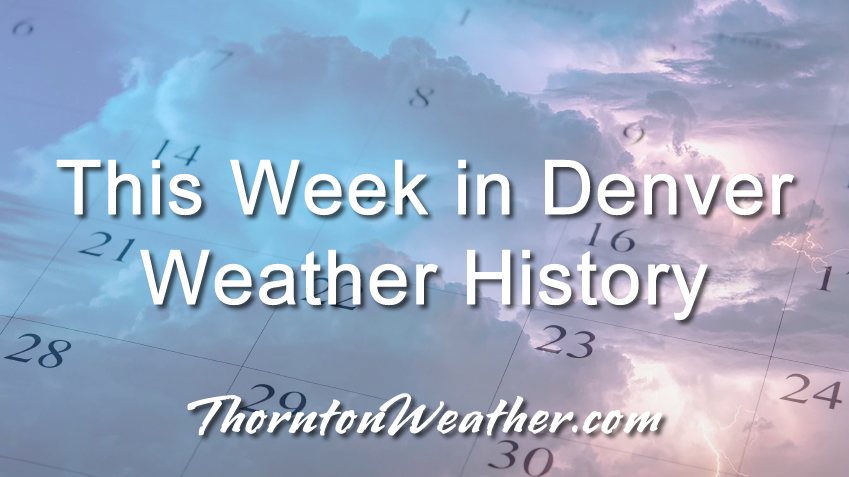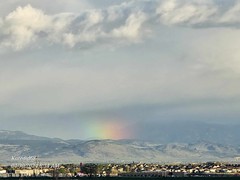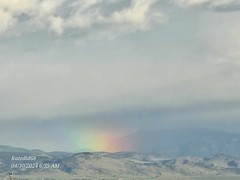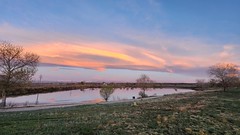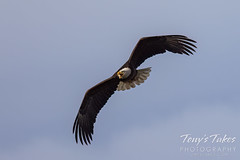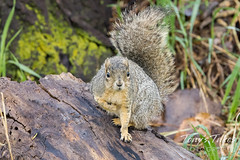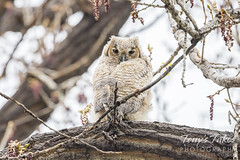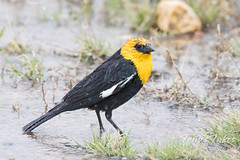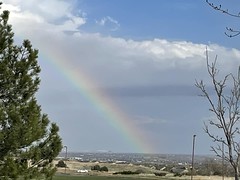
May can bring a variety of conditions from snow and cold to severe thunderstorms and flooding rains. Looking back at this week in Denver weather history we see where all of those events have made an appearance in our past.
From the National Weather Service:
29-30
In 1964…several weeks of dry weather and windy conditions across the Great Plains to the east caused noticeable suspended dust to invade metro Denver. At Stapleton International Airport east winds gusted to 28 mph and visibility was reduced to 5 miles.
In 1989…a late season snowstorm dropped 2 to 4 inches of snow across metro Denver with 6 to 12 inches in the foothills. Snowfall totaled 3.9 inches at Stapleton International Airport where northeast winds gusted to 23 mph and the greatest snow depth on the ground was 2 inches due to melting.
In 1991…a pacific storm dumped heavy wet snow across metro Denver. The foothills were hit the hardest where snowfall amounts ranged from 16 inches at Evergreen to 5 inches at Idaho Springs. Lower elevations of metro Denver received 5 to 9 inches of snowfall with 5 inches in Boulder and 7.0 inches at Stapleton International Airport where northeast winds gusted to 25 mph. The weight of the snow caused power lines to fall and tree limbs to snap…producing power outages in parts of Denver…Aurora…and Westminster.
In 1999…heavy snow fell overnight in the foothills above 7500 feet elevation. Snowfall totals included: 13 inches near Rollinsville…10 inches near Evergreen…8 inches at Blackhawk and Nederland…and 7 inches at Conifer. Only rain fell across the city with 2.13 inches recorded at Denver International Airport.
29-2
In 1954…a major storm dumped 10.1 inches of snowfall at Stapleton Airport. Most of the snow…7.5 inches…fell on the 29th and 30th. The maximum snow depth on the ground was 5 inches on the 30th due to melting. No strong winds accompanied the storm.
30
In 1896…northwest winds were sustained to 55 mph with gusts as high as 64 mph in the city.
In 1960…the minimum temperature dipped to 22 degrees at Stapleton Airport. The sub-freezing cold damaged fruit trees and some other crops in the area.
In 1967…west winds gusted to 51 mph at Stapleton International Airport. Winds were strong and gusty across all of metro Denver.
In 1972…hail 1/2 to 3/4 inches in diameter fell at Stapleton International Airport. Northwest winds gusted to 35 mph.
In 1980…a cold air funnel touched down several times near Louisville.
In 1983…mothball-size hail fell in Wheat Ridge.
In 1992…the all-time highest recorded temperature in April… 90 degrees…occurred. This is also the earliest 90 degree reading for the season. In addition…the temperature dipped to a low of only 56 degrees…setting a record high minimum for the date.
In 1995…hail…up to 3/4 inch in diameter…fell at Denver International Airport. The hail was soft…lasted for only 8 to 10 minutes…and caused no damage.
In 2002…drought conditions started to have an effect on greater metro Denver. April…normally the third snowiest month of the year in Denver averaging just over 9 inches of snow…ended with only a trace of snow…ranking the month… Along with previous Aprils…the 2nd least snowiest on record. The month ended with only 0.23 inch of liquid precipitation making the month the 3rd driest on record. Mountain snowpack was less than half of normal for this time of year. A statewide drought emergency was declared by the governor.
In 2003…a small tornado touched down 10 miles east of Hudson… But did no damage. Hail as large as 3/4 inch in diameter fell in Aurora near Cherry Creek.
In 2004…post-frontal upslope flow produced light snowfall across metro Denver. Snowfall was 4.0 inches at Denver Stapleton…while the temperature hovered in the lower 30’s all day. The high temperature was only 33 degrees…a record low maximum for the date. The low temperature of 30 degrees was not a record. North winds gusted to 20 mph at Denver International Airport.
30-1
In 1980…to the west of Denver…heavy rain changing to snow buried the foothills above 7 thousand feet in 4 to 8 inches of snow. Precipitation in the foothills ranged from 1 to 3 inches…which caused some local flooding. Rain fell at lower elevations. Rainfall at Stapleton International Airport totaled 1.05 inches from the storm.
1
In 1902…northwest winds were sustained to 68 mph with gusts as high as 74 mph in the city during the early morning. The apparent very strong Chinook winds warmed the temperature to a high of 78 degrees.
In 1912…south winds were sustained to 42 mph with gusts as high as 58 mph. South to southwest winds were strong all afternoon.
In 1935…a moderate duststorm blew into the city at around 2:00 pm on northwest winds sustained to 17 mph with gusts to 19 mph. Later in the afternoon…the dust receded to the east in advance of a rainstorm from the west.
In 1988…very strong winds behind a vigorous cold front produced a blinding dust storm that closed I-70 east of Denver. Northeast winds over metro Denver peaked to 45 mph at Stapleton International Airport…but only kicked up some blowing dust. The temperature plunged from a high of 76 degrees at midday to 36 degrees at midnight as light rain changed to light snow.
In 1991…3/4 inch diameter hail fell at Standley Lake in northwest metro Denver.
In 1999…heavy snow developed in the foothills above 7 thousand feet elevation. Snow totals included: 10 inches at Rollinsville…7 inches near conifer…and 6 inches atop Crow Hill. Rain fell across metro Denver.
In 2015…a teenager was critically injured when he struck by lightning near Town Center Mall in Aurora. He was standing on a hill in an open field. A severe thunderstorm produced hail up to quarter size near Evergreen.
1-2
In 1903…post-frontal rain changed to light snow overnight… But totaled only 2.0 inches. This was the last snow of the season. Northeast winds were sustained to 45 mph with gusts to 48 mph on the 1st.
1-5
In 1898…snowfall totaled 15.5 inches in downtown Denver. Most of the snow…6.2 inches…fell on the 3rd. Most of the snow melted as it fell. The greatest snow depth on the ground was only 2.5 inches on the 3rd at 8:00 pm. This was the only snowfall during the month. Northeast winds were sustained to 22 mph on the 1st.
2
In 1874…strong winds upset two railroad passenger coaches near Georgetown. The baggage was retrieved and placed in a heavy…large wagon. The passengers then seated themselves on top of the baggage. Another strong gust of wind upset the wagon. The driver’s shoulder was dislocated…and a passenger’s leg was badly injured. In Denver…northwest winds increased and blew in gusts and heavy winds were observed on the ridge tops. On the Kansas Pacific R.R. east of Denver…the wind was so strong that it blew the train back several lengths…which caused the train to be about 7 hours late arriving in the city.
In 1901…south winds were sustained to 50 mph with gusts to 60 mph from an apparent thunderstorm with hail.
In 1944…snowfall of 8.3 inches was accompanied by a thunderstorm. This was the last snowfall of the season and the only snow of the month. Northwest winds were sustained to 25 mph.
In 1955…southwest winds at speeds of 37 mph with gusts as high as 58 mph caused some blowing dust at Stapleton Airport.
In 1983…1 inch diameter hail fell a few miles south of Bennett.
In 1984…3/4 inch diameter hail fell in Northglenn.
In 1988…I-70 east of Denver was closed for the second straight day…this time due to snow and blowing snow producing up to 2 foot drifts. While only 2 to 4 inches of snow fell across metro Denver…Strasburg…just east of Denver…received a foot of snow. North winds peaked to 51 mph at Stapleton International Airport where snowfall totaled only 1.3 inches.
In 1995…lightning struck a house in Westminster sparking an attic fire.
In 2015…a sudden wind gust associated with a dissipating thunderstorm caught some flags attached to a lift and tipped it. Two men were injured when a lift at Civic Center Park in Denver fell on them during Cinco de Mayo festivities. Both men suffered from head injuries…one was in serious condition.
2-3
In 1979…heavy rain changed to snow on the 2nd. Snowfall totaled 3.9 inches at Stapleton International Airport… Where northwest winds gusted to 26 mph. The greatest depth of snow on the ground was only 1 inch at midday on the 2nd due to melting. Total precipitation for the 2 days was 1.65 inches.
2-4
In 1987…a slow moving storm brought rain…wind…and snow to metro Denver. Rainfall totaled 1.04 inches at Stapleton International Airport where north winds gusted to 48 mph on the 3rd. The foothills received 5 to 10 inches of snow.
2-5
In 2001…a very slow moving pacific storm system became parked near the four corners region…which allowed heavy snow to develop above 6500 feet in the foothills with a mix of rain and snow over lower elevations of metro Denver. Snowfall totals included: 21 inches atop Crow Hill and at Idaho Springs; 19 inches near Blackhawk; and 18 inches in Coal Creek Canyon…Genesee…and 11 miles southwest of Morrison. Snowfall totaled 6.2 inches at the site of the former Stapleton International Airport. Precipitation (rain and melted snow) totaled 2.09 inches at Denver International Airport where north winds gusted to 30 mph on the 2nd.
3
In 1898…heavy snowfall of 6.2 inches fell over downtown Denver. Most of the snow melted as it fell. The greatest snow depth on the ground was 2.5 inches during the evening.
In 1907…the all-time lowest recorded temperature in the month of May…19 degrees…occurred.
In 1925…an apparent microburst produced sustained northeast winds to 44 mph with gusts to 52 mph. Rainfall was only 0.01 inch in downtown Denver.
In 1981…lightning struck 9 golfers at the south suburban golf course. None were injured seriously.
In 1983…hail 1 1/2 inches in diameter fell at Green Mountain west of Lakewood…with 3/4 inch stones reported in Lakewood.
In 1986…a thunderstorm wind gust to 51 mph was recorded at Stapleton International Airport.
3-5
In 1908…rain changed to snow on the evening of the 3rd and continued through the early evening of the 5th. Snowfall totaled 10.0 inches over downtown Denver. This was the last measurable snow of the season. Precipitation totaled 1.51 inches. North winds were sustained to 23 mph on the 3rd…33 mph on the 4th…and 21 mph on the 5th. Three temperature records were set. High temperatures of 30 degrees on the 4th and 38 degrees on the 5th were record low maximum temperatures for the dates. The reading on the 4th was also the all-time record low maximum for the month of May.
In 2007…a slow moving pacific storm system…from the desert southwest…brought a period of unsettled weather to the region. During the 3-day period…locally heavy snow was reported over parts of the Front Range foothills. Storm totals included: 15 inches near Conifer…14.5 inches west of Jamestown…13.5 inches; 6 miles southwest of Evergreen…and 12.5 inches at Pine Junction. Severe thunderstorms…producing large hail…up to one inch in diameter were observed in the vicinity of Boulder and Hudson. Lightning struck a residence in Jefferson County. The roof was hit…causing the attic to catch fire. At Denver International Airport…lightning struck a United Airlines jet as it was pushing away from the gate. The passengers were taken off the jet and put on another plane. Continue reading April 30 to May 6: This week in Denver weather history →



